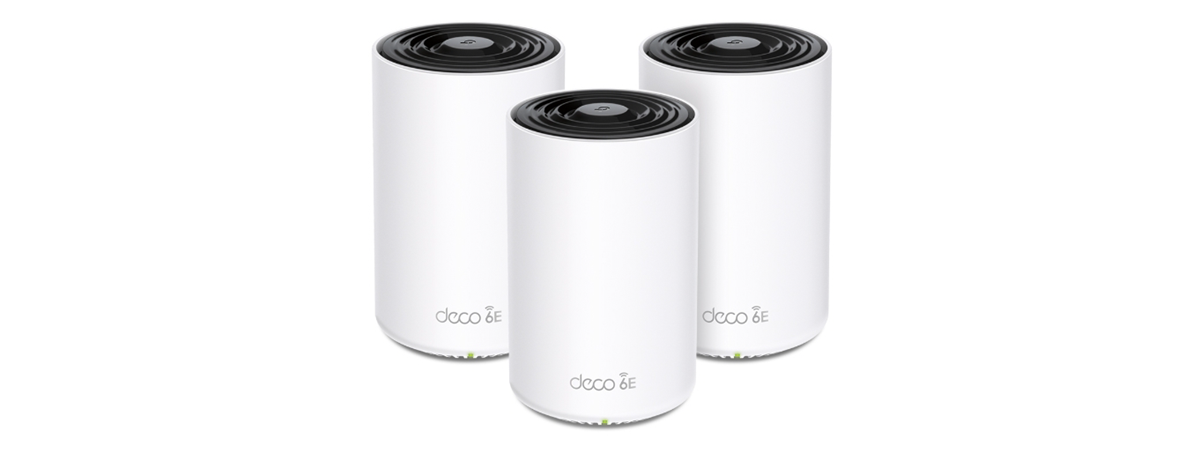
Wireless network performance
My test apartment is set up similarly to the diagram below. As you can see, I’ve placed the main ASUS ZenWiFi Pro ET12 in the largest room, where I spend most of my day. Unfortunately, my apartment is too small to fully test such a powerful mesh Wi-Fi system, and I placed the second node in Room 1 to also provide better Wi-Fi in Room 2, where most routers struggle.
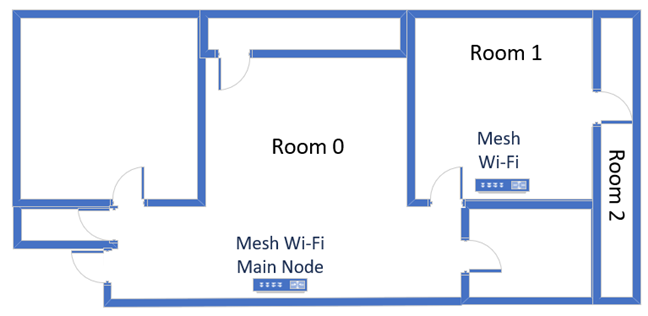
The apartment in which I tested ASUS ZenWiFi Pro ET12
I evaluate the quality of the wireless network managed by ASUS ZenWiFi Pro ET12 through measurements made in three different places:
- I record the maximum speeds when no walls absorb the wireless signal in the room where the main node is placed.
- Room 1 - is separated by one wall from the main node.
- Room 2 - is separated from the main node by two walls absorbing the wireless signal. Also, the wall between Room 1 and Room 2 is twice as thick as the one between the router’s room and Room 1. Room 2 can be a difficult challenge for many routers, but it should not be a problem for a mesh Wi-Fi system.
I’ve made all my measurements using a new ASUS ROG Zephyrus G14 laptop that works great on Wi-Fi 6E networks and is running Windows 11 with the latest drivers and operating system updates.

I made my measurements on an ASUS ROG Zephyrus G14
I had to make some comparisons to better understand how this mesh Wi-Fi system performs. Unfortunately, I didn’t test any other mesh Wi-Fi in my new apartment, so I’ve compared ASUS ZenWiFi Pro ET12 with Synology RT6600ax (one of my favorite Wi-Fi 6 routers on the market) and TP-Link Archer GX90 (a powerful gaming router with excellent wireless coverage).
How the ASUS ZenWiFi Pro ET12 performs on the 2.4 GHz band
I first measured the signal strength using NetSpot. When using the Wi-Fi 4 standard on the 2.4 GHz band, the signal strength offered by ASUS ZenWiFi Pro ET12 was solid everywhere. I expected this due to the fact that we’re dealing with a mesh Wi-Fi system with two stations instead of a router. It is easier for a mesh Wi-Fi to provide better signal strength over a large area than for a router.

Signal strength on Wi-Fi 4 (2.4 GHz band)
Switching to the Wi-Fi 6 standard on the 2.4 GHz band meant better signal strength everywhere in my apartment.

Signal strength on Wi-Fi 6 (2.4 GHz band)
Next, I used the SpeedTest app to measure the maximum speed you get when transferring data to and from the internet on the 2.4 GHz band, using Wi-Fi 4. Again, download speeds were good everywhere in my apartment, especially in Room 2, where routers don’t usually deliver strong coverage.

SpeedTest - The download speed on Wi-Fi 4 (2.4 GHz)
Uploads were performed at slower speeds, but they were still fast in all rooms.
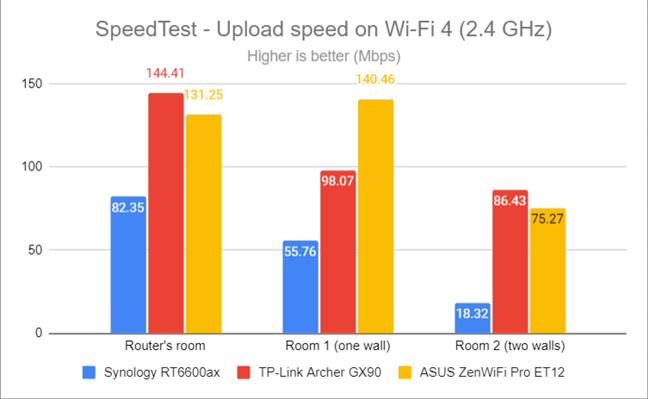
SpeedTest - The upload speed on Wi-Fi 4 (2.4 GHz)
I then switched to Wi-Fi 6 on the 2.4 GHz band and repeated the same measurements. Again, ASUS ZenWiFi Pro ET12 delivered an outstanding download speed upgrade, especially in the rooms furthest from the main station.
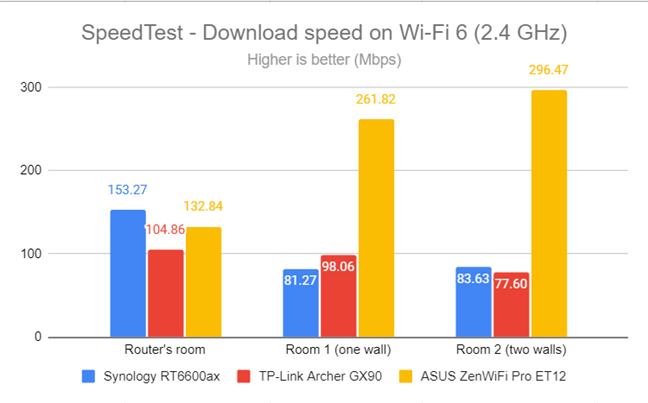
SpeedTest - The download speed on Wi-Fi 6 (2.4 GHz)
Uploads were just as impressive when using Wi-Fi 6 on the 2.4 GHz band.

SpeedTest - The upload speed on Wi-Fi 6 (2.4 GHz)
For the next set of measurements, I used the PassMark Performance test to transfer data between two computers connected to the network. Again, I was on the 2.4 GHz band using the Wi-Fi 4 standard. Unfortunately, this time the download speeds offered by ASUS ZenWiFi Pro ET12 were not that impressive.

Network Wi-Fi downloads on Wi-Fi 4 (2.4 GHz)
However, the upload speed improved, getting close to the numbers I saw earlier with SpeedTest.

Network Wi-Fi uploads on Wi-Fi 4 (2.4 GHz)
I repeated the same measurements on the 2.4 GHz band, using the Wi-Fi 6 standard. Again, I noticed a significant improvement in download speeds, especially in the rooms furthest from the main station.
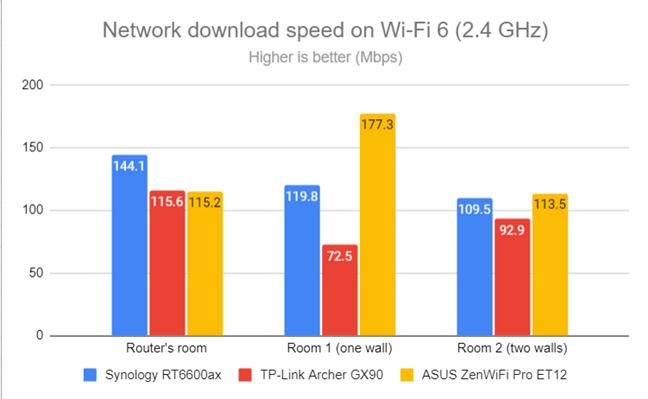
Network Wi-Fi downloads on Wi-Fi 6 (2.4 GHz)
The same happened with the upload speeds, which increased significantly everywhere in my apartment.

Network Wi-Fi uploads on Wi-Fi 6 (2.4 GHz)
ASUS ZenWiFi Pro ET12 offers a large coverage area on the 2.4 GHz band. I appreciate that switching from Wi-Fi 4 to Wi-Fi 6 on this band delivers meaningful improvements in speed and signal strength, which is great.
How the ASUS ZenWiFi Pro ET12 performs on the 5 GHz band
I moved on to the 5 GHz band and repeated the same measurements performed on the previous band. I started using the Wi-Fi 5 standard and fired up NetSpot to analyze the signal strength. ASUS ZenWiFi Pro ET12 didn’t disappoint and delivered excellent results in all rooms.

Signal strength on Wi-Fi 5 (5 GHz band)
The situation was similar when switching to Wi-Fi 6 on the 5 GHz band.

Signal strength on Wi-Fi 6 (5 GHz band)
Moving on, I used the SpeedTest app to see how fast the internet connection is when using the Wi-Fi 5 standard. ASUS ZenWiFi Pro ET12 delivered fast downloads everywhere in my apartment, easily outperforming the routers I’ve compared it to.

SpeedTest - The download speed on Wi-Fi 5 (5 GHz)
Uploads were also very fast in all the rooms of my apartment.

SpeedTest - The upload speed on Wi-Fi 5 (5 GHz)
When switching to the Wi-Fi 6 standard on the 5 GHz band, the download speed further improved in all the rooms, which is great.

SpeedTest - The download speed on Wi-Fi 6 (5 GHz)
The upload speed improved by a lesser degree. However, using Wi-Fi 6 was still faster than using Wi-Fi 5.

SpeedTest - The upload speed on Wi-Fi 6 (5 GHz)
I switched to the PassMark Performance test and transferred data between two computers connected to the network. This benchmark tells me the average speed you get when transferring data only inside the network and not on the internet. For example, when using Wi-Fi 5, the download speeds offered by ASUS ZenWiFi Pro ET12 breached the 1 Gbps mark, which is great.

Network Wi-Fi downloads on Wi-Fi 5 (5 GHz)
Uploads were fast too, but below the 1 Gbps mark.

Network Wi-Fi uploads on Wi-Fi 5 (5 GHz)
Switching to the Wi-Fi 6 standard meant that downloads got a bit faster everywhere. ASUS ZenWiFi Pro ET12 performed beautifully in all the rooms of my apartment, easily showcasing the coverage advantage offered by a mesh Wi-Fi system over a single router.

Network Wi-Fi downloads on Wi-Fi 6 (5 GHz)
Uploads were super fast too, but they breached 1 Gbps only in the room where the main unit was placed.

Network Wi-Fi uploads on Wi-Fi 6 (5 GHz)
ASUS ZenWiFi Pro ET12 is an excellent performer on the 5 GHz band, both when using Wi-Fi 5 and Wi-Fi 6. It offers excellent coverage, signal strength, and speed.
Wired network performance
It was time to evaluate the performance of Ethernet network connections. My internet connection offers a maximum of 1 Gbps for the download speed and 800 Mbps for the upload.
When using SpeedTest, ASUS ZenWiFi Pro ET12 had no problems getting close to the maximum speeds allowed by my internet provider.

SpeedTest on wired connections
The potential of the ASUS ZenWiFi Pro ET12 is a bit wasted on internet connections that are up to 1 Gbps. If you want to take advantage of everything it offers, it is best to use it with a 2.5 Gbps internet connection. There’s also a minor downside: no USB port on the ASUS ZenWiFi Pro ET12, even though more affordable solutions from the same company, like the ASUS ZenWiFi AC (CT8), have a USB 3.0 port built-in.
Extra features
The firmware on the ASUS ZenWiFi Pro ET12 has a lot of advanced features that many will appreciate. First of all, security is a big deal on this mesh Wi-Fi system, and it provides the following tools:
- AiProtection - a comprehensive set of security tools that protect your network from attacks, malicious sites, infected devices, and poor router settings. You can find a useful tutorial about this feature here: ASUS AiProtection: On or Off? Enhance your router’s security!
- Parental Controls - efficient cloud-based parental controls, developed by ASUS and Trend Micro, alongside their AiProtection module. You can learn more about what they do from this article: 7 ways in which ASUS Parental Controls protect your children.
- VPN - is a major focus area, with three different services:
- VPN Server - the router can be set to work as a VPN server for your network, using the PPTP, OpenVPN, and IPSec VPN protocols.
- Instant Guard - a mobile app that helps smartphone users navigate the internet securely by establishing a VPN connection to their home network. The app is handy, especially when you have to use free public Wi-Fi networks, which tend to be insecure. For more details, read: How to configure and use Instant Guard on ASUS Wi-Fi routers.
- VPN Fusion - allows you to connect to multiple VPN servers simultaneously and assign your client devices to connect to different VPN tunnels.

ASUS ZenWiFi Pro ET12 features useful security tools
The list of features doesn’t stop here. ASUS ZenWiFi Pro ET12 also includes:
- AiMesh - you can add more ASUS ZenWiFi Pro ET12 units or other ASUS routers to extend your network further. For more details on how it works, read: What is an ASUS AiMesh network and how to create one?.
- Adaptive QoS - an easy-to-use Quality of Service feature that allows you to prioritize the traffic you want to get more bandwidth: games, media streaming, work-from-home, learn-from-home, web surfing, etc.
- Guest Network - you can enable three wireless guest networks with individual security and access settings on each band (2.4, 5, and 6 GHz).
- Traffic Analyzer - visual traffic statistics that clearly show how your network is used and by which devices.
- DDNS - allows you to connect to your mesh Wi-Fi from the internet, even if your internet provider assigns you a dynamic public IP address.
- Dual WAN - you can use two internet connections at the same time. However, the second must use a 1 Gbps port. You can’t simultaneously use two 2.5 Gbps internet connections.
- Amazon Alexa - you can say things like “Alexa, ask ASUS ROUTER to upgrade the firmware” to perform different tasks.
- Network Tools - for analyzing the network and identifying what’s wrong. They are helpful when you need to troubleshoot problems.
The features offered by ASUS ZenWiFi Pro ET12 are many, powerful, and useful. They match very well with what people want from premium networking devices.
What is your opinion about the ASUS ZenWiFi Pro ET12?
There was plenty to write about the ASUS ZenWiFi Pro ET12. At the end of this review, you should have a complete understanding of what you get when buying it and whether it matches your needs. Before closing, tell me what you think about the ASUS ZenWiFi Pro ET12: do you consider it a good mesh Wi-Fi system? Are you going to buy it? Comment below, and let’s discuss.


 12.07.2022
12.07.2022 

